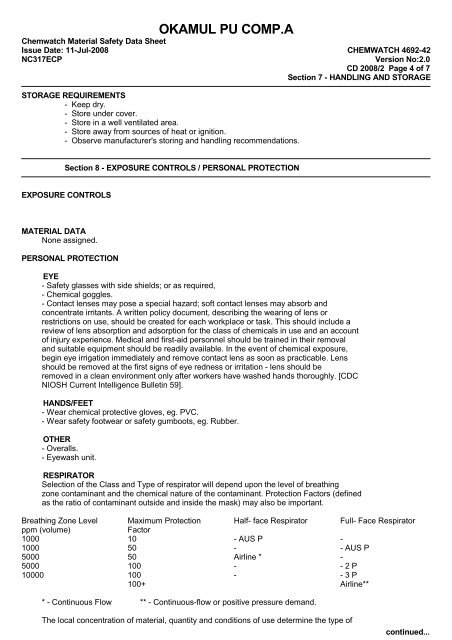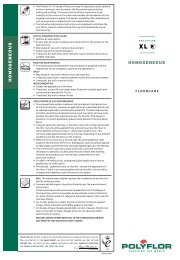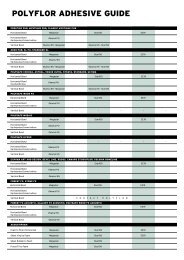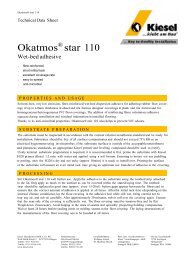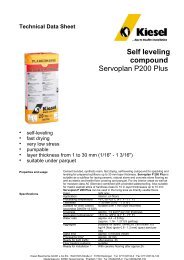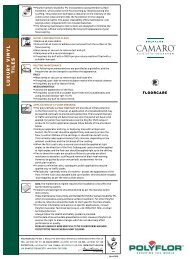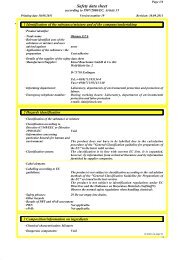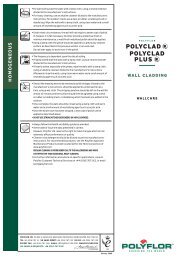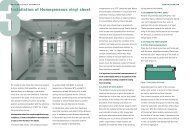MSDS Part 1 - Polyflor
MSDS Part 1 - Polyflor
MSDS Part 1 - Polyflor
You also want an ePaper? Increase the reach of your titles
YUMPU automatically turns print PDFs into web optimized ePapers that Google loves.
OKAMUL PU COMP.A<br />
Chemwatch Material Safety Data Sheet<br />
Issue Date: 11-Jul-2008 CHEMWATCH 4692-42<br />
NC317ECP Version No:2.0<br />
CD 2008/2 Page 4 of 7<br />
Section 7 - HANDLING AND STORAGE<br />
STORAGE REQUIREMENTS<br />
- Keep dry.<br />
- Store under cover.<br />
- Store in a well ventilated area.<br />
- Store away from sources of heat or ignition.<br />
- Observe manufacturer's storing and handling recommendations.<br />
Section 8 - EXPOSURE CONTROLS / PERSONAL PROTECTION<br />
EXPOSURE CONTROLS<br />
MATERIAL DATA<br />
None assigned.<br />
PERSONAL PROTECTION<br />
EYE<br />
- Safety glasses with side shields; or as required,<br />
- Chemical goggles.<br />
- Contact lenses may pose a special hazard; soft contact lenses may absorb and<br />
concentrate irritants. A written policy document, describing the wearing of lens or<br />
restrictions on use, should be created for each workplace or task. This should include a<br />
review of lens absorption and adsorption for the class of chemicals in use and an account<br />
of injury experience. Medical and first-aid personnel should be trained in their removal<br />
and suitable equipment should be readily available. In the event of chemical exposure,<br />
begin eye irrigation immediately and remove contact lens as soon as practicable. Lens<br />
should be removed at the first signs of eye redness or irritation - lens should be<br />
removed in a clean environment only after workers have washed hands thoroughly. [CDC<br />
NIOSH Current Intelligence Bulletin 59].<br />
HANDS/FEET<br />
- Wear chemical protective gloves, eg. PVC.<br />
- Wear safety footwear or safety gumboots, eg. Rubber.<br />
OTHER<br />
- Overalls.<br />
- Eyewash unit.<br />
RESPIRATOR<br />
Selection of the Class and Type of respirator will depend upon the level of breathing<br />
zone contaminant and the chemical nature of the contaminant. Protection Factors (defined<br />
as the ratio of contaminant outside and inside the mask) may also be important.<br />
Breathing Zone Level Maximum Protection Half- face Respirator Full- Face Respirator<br />
ppm (volume) Factor<br />
1000 10 - AUS P -<br />
1000 50 - - AUS P<br />
5000 50 Airline * -<br />
5000 100 - - 2 P<br />
10000 100 - - 3 P<br />
100+ Airline**<br />
* - Continuous Flow ** - Continuous-flow or positive pressure demand.<br />
The local concentration of material, quantity and conditions of use determine the type of<br />
continued...


